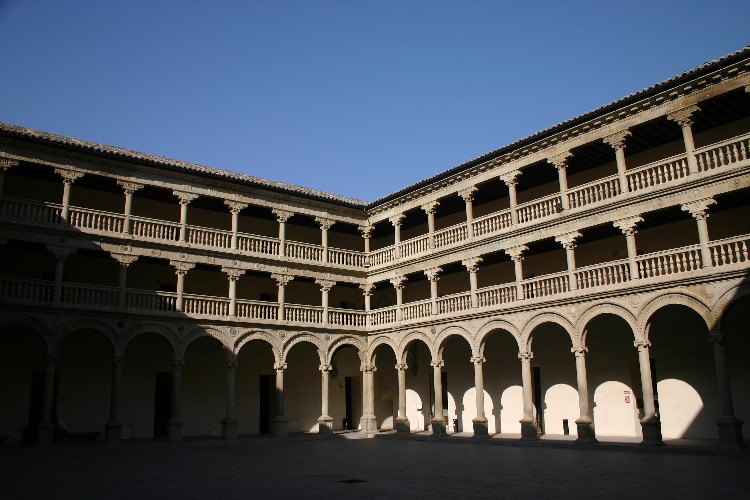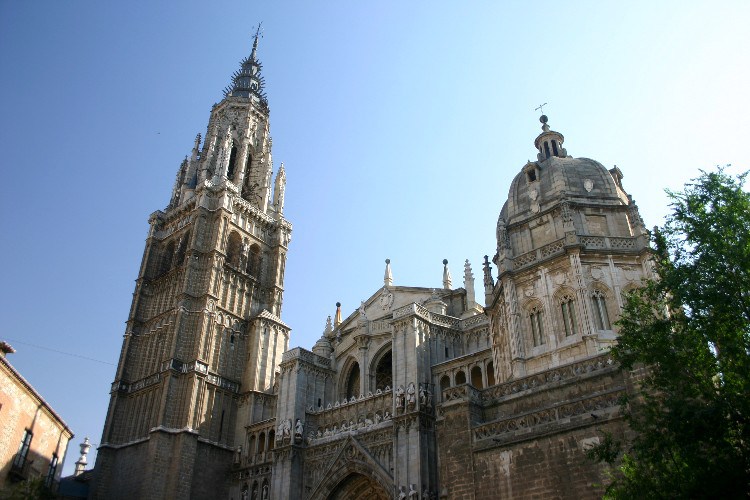Holy Toledo! We now understand where this exclamation comes from.
Likeing Toledo so far? Consider checking out our full Spain canon here!
Toledo is crammed with churches, cathedrals, former mosques, and former synagogues. It is the center of the Catholic Church in Spain and was Spain’s capital until Carlos I abandoned his half-built Alcazar Palace (which he completed anyway) for Madrid. El Greco also made it his home; many pieces of his work are scattered around the city for us to see. We arrive in Toledo España by 10:00 a.m., find some parking and take the escalators opened by King Juan Carlos up, up, up to the top of the town. We grab a not-too-helpful map from the very helpful tourist board and start to discover the old town of Toledo. We walk past one church with its doors wide open and walk in. Not very interesting (maybe that’s why there is no admission charge or “voluntary donation” demanded of us). We walk out the front door into an inner courtyard and keep moving forward through more inner courtyards. We have found our way into the university, but we can’t find our way out… until finally, feeling like we’ve walked from one side of Toledo to the other, down the hill and back up the other side, we find an exit onto a street. We walk down the street, into a nice plaza which isn’t marked on our map. Holy Toledo indeed!
El Greco’s, a Titian, a Bassano, even a Van Dyck. Holy Toledo!
Finally, we find the tourist route and begin our tour of Toledo in earnest. The first stop is City Hall, the Ayuntamiento, quite an attractive building with a somewhat Germanic feeling. It must date from the Hapsburg period. We are a short walk from the Catedral, home to the Inquisition, famous for not hiring El Greco to paint its murals. In the Catedral, we read of the sign that celebrates the 1492 expulsion of the Jews from Spain by Ferdinand and Isabel. Bankrupt and unable to repay the loans from the Jews that had financed their retaking of Spain from the Muslims, they chose to expel the Jews to escape their debts. Unlike most of the throng making its way through the Catedral, we pay the 5.50 Euro entrance fee to get into the Sacristia, where we are overwhelmed with the art: it is full of El Greco’s, a Titian, a Bassano, even a Van Dyck.
Out of the Catedral, we walk to the Alcazar. It was virtually destroyed during the Civil War, but Franco, whose forces were holed up inside it, had it rebuilt.
A Final Masterpiece
We walk through Toledo, getting lost and finding ourselves. Finally, just as we decide it is time to return to Madrid, we stumble upon Santo Tomé, home to El Greco’s masterpiece El Entierro del Conde de Orgaz, which tells the story of the burial of the Count of Orgaz, when Saints Augustine and Stephen descended from heaven to attend the funeral. Interestingly, El Greco painted himself and his son into the picture, although the funeral happened 300 years before the painting was done. We spend a good hour in the church, looking at and thinking about this important painting.










Comments